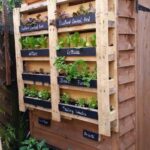Are you looking for ideas for sloped gardens? Working with a sloped garden presents unique challenges and opportunities for creating a stunning outdoor space. From terracing to planting on slopes, there are various ways to transform a sloped garden into a beautiful and functional landscape.
Sloped gardens can be both challenging and rewarding to work with. The incline of the land provides an opportunity for creative design elements such as terraced areas, retaining walls, and unique planting arrangements. However, managing soil erosion and water drainage can also present significant challenges when it comes to maintaining a sloped garden.
Throughout this article, we will explore various design ideas and practical tips for working with sloped gardens. From creating terraced areas to incorporating water features and strategic lighting, we will provide inspiration and guidance for making the most of your sloped landscape. Whether you’re dealing with a gentle slope or a steep incline, there are plenty of possibilities for transforming your sloped garden into an inviting and visually striking outdoor space.
Terracing
Some design ideas for terracing a sloped garden include:
- Building retaining walls: Constructing retaining walls using natural stone or interlocking blocks can help create level terraces while adding visual interest to the landscape.
- Planting different levels: Utilize each terrace for specific types of vegetation, such as flowering plants on one level, shrubs on another, and perhaps a small vegetable or herb garden on yet another level.
- Adding seating areas: Incorporate built-in seating or space for outdoor furniture to create inviting areas for relaxation and entertainment.
When considering terracing as part of your landscaping plan, it’s essential to work with the natural slope of the land and take into account factors like sunlight exposure and water drainage. By carefully planning and implementing terraced areas, you can make the most of your sloped garden while creating an aesthetically pleasing and functional outdoor space.
In addition to their aesthetic appeal, terraced gardens also offer practical solutions for managing soil erosion on a slope. The various levels created by terracing can help slow down the flow of water during heavy rainfall, reducing soil runoff and retaining moisture in the ground.
This makes terracing an excellent option for sustainable landscaping practices in sloped gardens. With thoughtful design and careful construction, terraced areas can contribute to the overall health and beauty of your garden while addressing some of the challenges associated with gardening on slopes.
Planting on Slopes
When it comes to planting on slopes, it’s important to choose vegetation that can thrive in the unique conditions of a sloped garden. Here are some tips and suggestions for selecting and planting the right vegetation for your sloped garden:
- Consider erosion control: Choose plants with strong root systems that can help prevent soil erosion on your sloped garden. Grasses such as vetiver and shrubs like juniper are excellent choices for stabilizing the soil on slopes.
- Choose low-maintenance plants: Since working on a sloped garden can be challenging, opt for low-maintenance plants that require minimal care. Groundcovers like creeping phlox or periwinkle are great options for adding color and texture to your sloped garden without requiring too much attention.
- Use native plants: Selecting native plants for your sloped garden can help ensure that they thrive in the local climate and soil conditions. Look for native grasses, wildflowers, and shrubs that are well-suited for growing on slopes in your area.
In addition to these tips, it’s also important to pay attention to proper planting techniques when working on a sloped garden. Make sure to plant vegetation at appropriate angles to prevent soil erosion, and consider using mulch or other ground coverings to help retain moisture and protect against erosion. By choosing the right vegetation and implementing strategic planting techniques, you can create a beautiful and sustainable landscape in your sloped garden.
Retaining Walls
When dealing with a sloped garden, managing soil erosion is one of the key challenges that gardeners face. Retaining walls are an effective solution for this issue, while also adding visual interest to the landscape. There are various types of retaining walls that can be used in sloped gardens, each offering unique benefits and design possibilities.
Natural Stone Walls
One popular choice for retaining walls in sloped gardens is natural stone walls. These not only provide excellent support for holding back soil, but they also add a rustic and timeless charm to the garden. Natural stone walls can be built using a variety of different types of stone, allowing for customization to suit the aesthetic of the garden.
Timber Retaining Walls
For a more organic and sustainable look, timber retaining walls are another option to consider. These can be constructed using pressure-treated wood or other rot-resistant materials to ensure longevity and durability. Timber retaining walls can blend seamlessly into the natural surroundings of a sloped garden and can be especially appealing in rustic or woodland-themed landscapes.
Concrete Block Walls
If a more modern and structured look is desired, concrete block retaining walls may be the best choice. These walls are durable and can be easily tailored to fit the specific requirements of the slope. With concrete blocks available in various colors and textures, there is ample opportunity to create visually striking designs that complement the overall aesthetic of the garden.
By utilizing different types of retaining walls in a sloped garden, it is possible to effectively manage soil erosion while enhancing the overall appeal of the landscape. Whether choosing natural stone, timber, or concrete blocks, each option offers its own advantages in terms of both functionality and design flexibility.
As with any hardscaping feature in a garden, it’s important to carefully consider factors such as drainage, soil composition, and local building codes when planning and installing retaining walls on slopes.
Paths and Steps
When it comes to designing a sloped garden, creating functional and visually appealing pathways and steps is essential for both practicality and aesthetics. Sloped gardens present a unique challenge when it comes to navigating the space, but with the right design ideas, paths and steps can enhance the overall look of the garden while providing easy access to different areas.
Curved Paths
One way to add visual interest to a sloped garden is by incorporating curved paths that follow the natural contours of the land. This not only creates an organic flow throughout the garden but also helps to break up the steepness of the slope. Using materials such as gravel, flagstone, or pavers can further enhance the beauty of these pathways while providing a stable surface for walking.
Stone Steps
For steeper slopes, incorporating stone steps can help make the garden more accessible while adding a rustic and charming touch. Natural stone steps blend seamlessly into the landscape and can be designed in various shapes and sizes to accommodate different levels of elevation. Consider integrating plantings alongside the steps to soften their appearance and add a pop of color.
Staircases
In some cases, a more formal staircase may be necessary for navigating larger changes in elevation within a sloped garden. These staircases can be made from materials such as wood, concrete, or stone and can be customized to suit the overall style of the garden. Lighting can also be added along staircases for both safety and ambiance during evening hours.
By carefully planning and designing pathways and steps in a sloped garden, homeowners can create an inviting outdoor space that is both functional and visually stunning. These design ideas provide inspiration for overcoming the challenges posed by sloped terrain while maximizing its potential for beauty and enjoyment.
Water Features
Ponds can be nestled into the lower areas of the slope, creating a serene focal point that adds dimension and character to the garden. Incorporating aquatic plants and fish can further enhance the beauty and ecological diversity of the pond. Meanwhile, cascading waterfalls can be integrated into the higher sections of the slope, utilizing gravity to create a natural flow that adds both auditory and visual interest to the landscape.
When designing water features for a sloped garden, it’s important to consider factors such as water circulation, maintenance access, and potential runoff during heavy rainfall. Additionally, incorporating indigenous landscaping around these water features can help create a harmonious environment that is both visually appealing and supportive of local wildlife.
Overall, water features offer endless possibilities for enhancing the aesthetics and atmosphere of sloped gardens. Whether it’s a tranquil pond nestled at the base of the slope or a dramatic cascading waterfall along its face, these elements can transform a challenging landscape into a breathtaking oasis. With careful planning and consideration of the garden’s unique layout, homeowners can create captivating water features that complement their sloped gardens beautifully.
Lighting
Strategic lighting can greatly enhance the beauty and safety of a sloped garden. When it comes to lighting, it’s important to consider both functionality and aesthetics. Lighting can serve as a practical solution to illuminate pathways and steps, making them safer to use at night. At the same time, carefully placed lights can also highlight the unique features of a sloped garden, creating a stunning visual effect.
One idea for sloped gardens is to use solar-powered lights along pathways and steps. These lights are not only energy-efficient but also easy to install since they don’t require any wiring. Additionally, they automatically turn on at dusk, providing consistent and low-maintenance illumination throughout the night.
Incorporating spotlights or uplights strategically throughout the garden can also create a dramatic effect by highlighting trees, shrubs, or other landscape elements. This not only adds visual interest but also extends the usability of the garden into the evening hours. To avoid potential glare and harsh shadows, it’s important to carefully consider the placement and angle of these lights.
When designing lighting for a sloped garden, it’s essential to take into account the natural contours of the land and any existing vegetation. The goal is to create a balance between functional lighting and accentuating the unique topography of the space. By carefully considering placement and type of lighting fixtures, a sloped garden can be transformed into an enchanting oasis that is both safe and visually appealing.
| Ideas for Sloped Gardens | Benefits |
|---|---|
| Solar-powered lights | Energy-efficient, easy installation |
| Spotlights/Uplights | Highlight landscape features, extend usability into evening hours |
Maintenance
In conclusion, tending to a sloped garden can be both challenging and rewarding. By implementing innovative ideas for terracing, planting on slopes, retaining walls, pathways, water features, and lighting, homeowners can transform a challenging landscape into a stunning and functional outdoor space. Utilizing terracing techniques not only adds visual interest but also maximizes the usable area of the garden. Additionally, carefully selecting and planting vegetation that thrives on slopes will contribute to the overall health and aesthetics of the garden.
Furthermore, incorporating well-designed pathways, steps, water features, and lighting can enhance safety and create an inviting atmosphere in a sloped garden. Water features like ponds or cascading waterfalls can add a soothing element to the garden while strategic lighting can highlight key areas and extend enjoyment into the evening.
Finally, ongoing maintenance is crucial for preserving the beauty and stability of a sloped garden. Implementing good drainage practices and erosion control measures will help to protect the integrity of the landscape. With careful planning and attention to detail in both design and maintenance, sloped gardens can become truly exceptional outdoor spaces.
Frequently Asked Questions
What Can I Do With a Slanted Garden?
A slanted garden can be a great opportunity to create different levels and add visual interest to your outdoor space. You can use retaining walls, terracing, or raised beds to make the most of the slope and create a unique and beautiful garden design.
How Can I Make My Sloped Yard Look Good?
Making a sloped yard look good involves strategic landscaping and planting choices. Utilize the natural slope by creating cascading plant beds or stair-step terraces. Incorporate hardscaping elements like pathways, stairs, or retaining walls to add structure and functionality to the space.
How Do You Plan a Garden on a Slope?
Planning a garden on a slope requires careful consideration of water drainage, erosion control, and plant selection. Start by evaluating the slope’s direction and sunlight exposure, then design terraced levels that work with the natural contours of the land.
Choose plants that are suitable for the microclimates created by the slope, such as drought-tolerant species for sunny areas and moisture-loving plants for shaded spots. Additionally, consider adding mulch or groundcovers to prevent soil erosion and retain moisture.

Welcome to my gardening blog! I am passionate about plants and enjoy sharing my knowledge and experiences with others. In this blog, I will write about everything related to gardening, from tips on how to get started to updates on my own garden projects.





